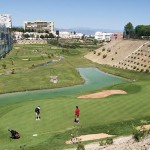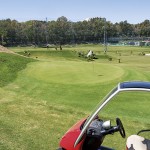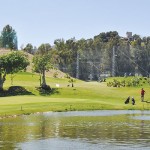Three decades after launching his golf career, Miguel Ángel Jiménez is embarking on a new professional and personal era. At 50, and after finishing fourth in the US Masters at Augusta, winning on his US Champions Tour senior debut and securing his first Spanish Open title, the Málaga-born golfer talks to Golf Circus about his current thoughts and aspirations, during an interview at his golf academy in Torremolinos.
He arrives in a slightly hurried state. “Now I’m with you. Sorry for the delay,” he says to our publisher and editor, José María Ferreira, “but I’ve been making myself look handsome – I’m getting married in a couple of days.” “Yes, I’ve head something about that,” our publisher replies, prompting a smile from the golfing star.
Now that you are getting married, how do you think it will be being away from home so often?
I don’t know, we’ll see, but what I do know is that catching flights is not my thing. If it weren’t for the fact that this means I can do something I like doing, competing, then I wouldn’t be taking any flight.”
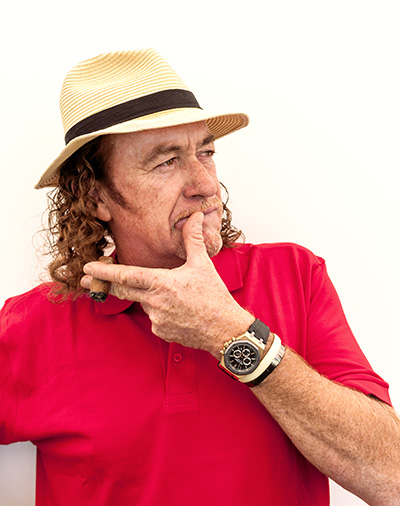 Today you are meeting us at your academy, a dream project which has finally become a reality. Tell us a bit about how the idea evolved…
Today you are meeting us at your academy, a dream project which has finally become a reality. Tell us a bit about how the idea evolved…
I’m always aware that I should return to this sport everything it has given me. This is a purely personal project.
It was inaugurated about a year ago but when did the idea originate?
Actually quite a while ago. Initially it was a different project which, due to the crisis, was postponed, until the opportunity arose to do what today is a reality.
Has it had any kind of state backing?
Well, if you are referring to financial support I would say no – the project has been completed with its own resources. As I noted before, it’s a personal project undertaken with a large dose of enthusiasm, although that doesn’t mean it hasn’t also had lots of support from people who have been just enthusiastic about it as me.
When we look at these greens it’s hard to stop thinking about how much they must have cost. Can you give us an idea how they have been built? I understand the finest materials have been used and they have been built “like the best”.
The greens have been built on a foundation of rocks and smaller pebbles and with thorns for perfect drainage. It doesn’t rain a lot here but it is very heavy, and no one likes to get wet, so it’s been built so that when the rain stops you can come out onto the course and there’s not a single drop of water. Furthermore, all the excess water goes into the recycling lake.
What were you thinking about when considering the design of these holes? And the slopes of the greens?
I thought it should be a course that suits all kinds of players. The greens are designed to be challenging from the tee and, if you miss on the green, to have a chance to recover, so there are various different undulations which are ideal both for fine-tuning your game and for practice by top-level golfers.
The seventh hole is copied from the 12th at August National…
Yes. I call it “Angustias” (“Angst”) and it’s a replica of the Augusta National hole.
Why specifically that one?
Well, because it’s one of the world’s flagship par-threes, if not the most renowned.
Is it the toughest par-three you have ever played?
It’s a hole where you can hit a good shot using a nine or eight-iron. By that I mean to say that you don’t need a 220-metre par-three for it to be a good par-three. In fact, there are none with these features that are classified among the best in the world. I don’t know which of the two is more difficult.
Why no copies of other famous holes?
It’s not that I wouldn’t have liked to, I can assure you. It was outside the budget, but all the rest are my own invention and I hope the course is a challenge for players.
We normally think that a pitch and putt is for beginners or high-handicap players. Your course is extremely challenging. In fact, you use it yourself to train, even the week before leaving for August when, I’ve been told, you had the greens almost as fast as over there. Why did you create it that way?
August is a course that requires your absolute best and calls for an incredible short game and putting. What we’ve done here is to prepare the greens so you can develop your game, perfect it and experience everything that happens in the short game.
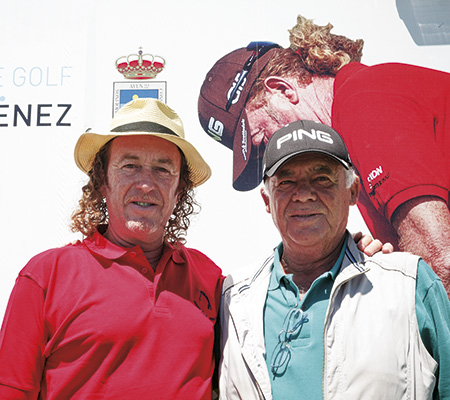 At this moment, his eldest brother Juan passes by and Miguel Ángel asks him to stay, for a photo to accompany our interview. He began with him as a caddie at Torrequebrada, where Juan worked.
At this moment, his eldest brother Juan passes by and Miguel Ángel asks him to stay, for a photo to accompany our interview. He began with him as a caddie at Torrequebrada, where Juan worked.
Your brother Juan is perhaps one of the people who have helped you most, at a technical level, with your golf. He’s the academy’s technical director, no?
Without a doubt. I’m proud to say that my brother Juan is the person who has helped me most – he was the one who taught me to play golf. So I couldn’t have found anyone better to run the academy.
And any of us can take classes with him?
Certainly, anyone can talk to him about taking classes – that’s why we’re here. Juan is a complete professional in this respect: he can evaluate the level and needs of each player – either beginner or more experienced player – and in each case their progress will be significant.
Do you run beginners’ courses?
Yes, we run all kinds of classes, beginners, fine-tuning, in groups…
Over the weekend I saw lots of children here. Do you have special courses for them? During the mid-term holidays and Easter you had special courses. Are you preparing something for summer?
Lots of children are taking classes here. From 20 June we will have a special area for them and throughout the year, during the holidays, we’ll have courses especially for children.
The holidays are quite long, especially for parents, who these days have to work, and it’s good for youngsters to do any kind of sport and have contact with other children.
Golf is a sport in which – particularly on the Costa del Sol – you tend to find children of different nationalities, and that’s enriching for anyone, but especially for those who still have much to learn, and it teaches them to be tolerant. My own children have taken part in summer courses and it’s been great for them. Sport, co-existence and being part of a group help you to become a better person
You’ve organised a circuit for children, the Miguel Ángel by Capitrans junior circuit. What is its objective?
Well, it’s quite clear to me. The foundation, not only of sport but also of any society, is with children. Maybe tomorrow they won’t all be elite sports stars but they’ll be magnificent doctors, lawyers and plumbers, and sport helps them to excel in everything they learn. Sport gives you a clear and clean mind.
What facilities will the clubhouse have?
At first, just basic facilities, a changing room for men and another for women, a shop, an office, a storage room and a restaurant. The idea is that, if you’re working and have little time, in a couple of hours you can hit a few balls, have a shower, eat something and go back to work. Or, if you have more time, come along with the family. In short, the idea is to provide services to clients and create a space where people feel comfortable.
When do you expect it to be open?
We hope the opening will be 20 or 21 June.
Will people be able to see some of your personal items there – Ryder Cup bags, trophies, flags, photos of key moments in your golfing life…?
Of course. The clubhouse won’t be all that large – in total 300 square metres, 150 above and 150 below – but I believe it will be quite attractive. Some of my things will be on display, bags from my tournaments, from the Ryder Cup and some mementoes.
Can you describe for us briefly each of the holes?
It begins with two short holes, 70 or so metres.
The first hole is comfortable. The green is one of the flattest on the course, with a mound and a downhill slope to the right in the middle of the green. All the greens are elevated.
The second hole has a bunker defending it in the middle right of the green and a mound on the centre left where you have to be really accurate, because if you miss the green at the front or back you have a very tough approach. It’s a small green which requires accuracy for the distance.
The third hole is 105 metres to the middle of an elevated green, all a gentle rise, and the ball won’t hold in the middle part of the green. The flags are always at the front or back, where there is also a bunker.
The fourth hole is short, downhill about 80 metres with a bunker at the middle of the green and water to the right and left. The green extends over two gentle levels but with little difference between them. The tee shot is important here – you have to measure it well.
The fifth is 110 metres with a lake in front and two fig trees and a mound behind, which gives you a deep perspective; also on the rise and with a rib dividing the green.
The sixth is the shortest of them all, 54 metres, and I think it’s the toughest hole on the course. You have to hit a shot with backspin on the ball.
The seventh, “Angustias”, we’ve already talked about that.
The eighth is 110 metres downhill to the middle of the green, which is narrow and long with a bunker to the right and gentle undulation.
The ninth is 80 metres with a kidney-shaped green and a bunker to the right and a maintenance track to the left.
The vegetation comprises palm trees throughout the layout and oleander along the streams that run through the plot – we also have fig and olive trees.
In the latest Masters you were fourth. Were you nervous?
Nervous? Not at all – there’s tension and a lot of pressure, but not nerves. These kinds of situations aren’t easy to resolve if you’re not aware that pressure can wreck a shot, and that when it appears the only one who can resolve it is you.
And your sons, do they want to follow in your footsteps?
I would love it if one of the two wanted to play as a professional, but it’s probably too soon to know if this will happen. The older one is just about to turn 19 and is in the US studying his first year of business and golf, and the younger one is here in Spain studying at an English school and taking golf lessons.
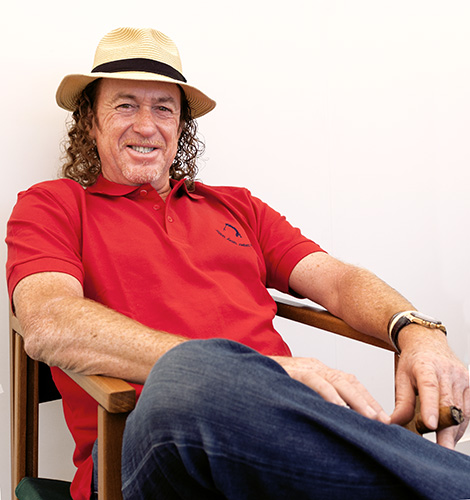 To play golf your head has to be in the right place, no?
To play golf your head has to be in the right place, no?
Definitely. The first thing is that you like what you’re doing, and my great good fortune has been to discover this and live from it. You can have a spot of luck but tournaments are not won by one shot – rather through your day-to-day work, practising, in the gymnasium, etc.
Your debut on the Champions Tour, and the final group with Langer (56 years) and Couples (54) and you (50), harked back to older times, like a duel from another era. What senior tour events will you be playing?
I’m only playing the event I just won, the Challenge Senior on the US PGA Tour and the British Senior Open Championship, because what truly motivates me at the moment is to play in the Ryder Cup. For me the Ryder Cup is one of the most important sports events in the world, at the same level as the Olympics and the football World Cup. There isn’t any other event that brings together so many people in just three days.
How do you see the future of Spanish golf?
Well, quite good because in Spain there aren’t all that many golfers – just 300,000 – and we always have eight or 10 among the world’s best. Not bad, no?
With whom would you have liked to play a round and at what course?
I don’t care which course but I would like to have played with Ben Hogan, who developed the modern swing.







